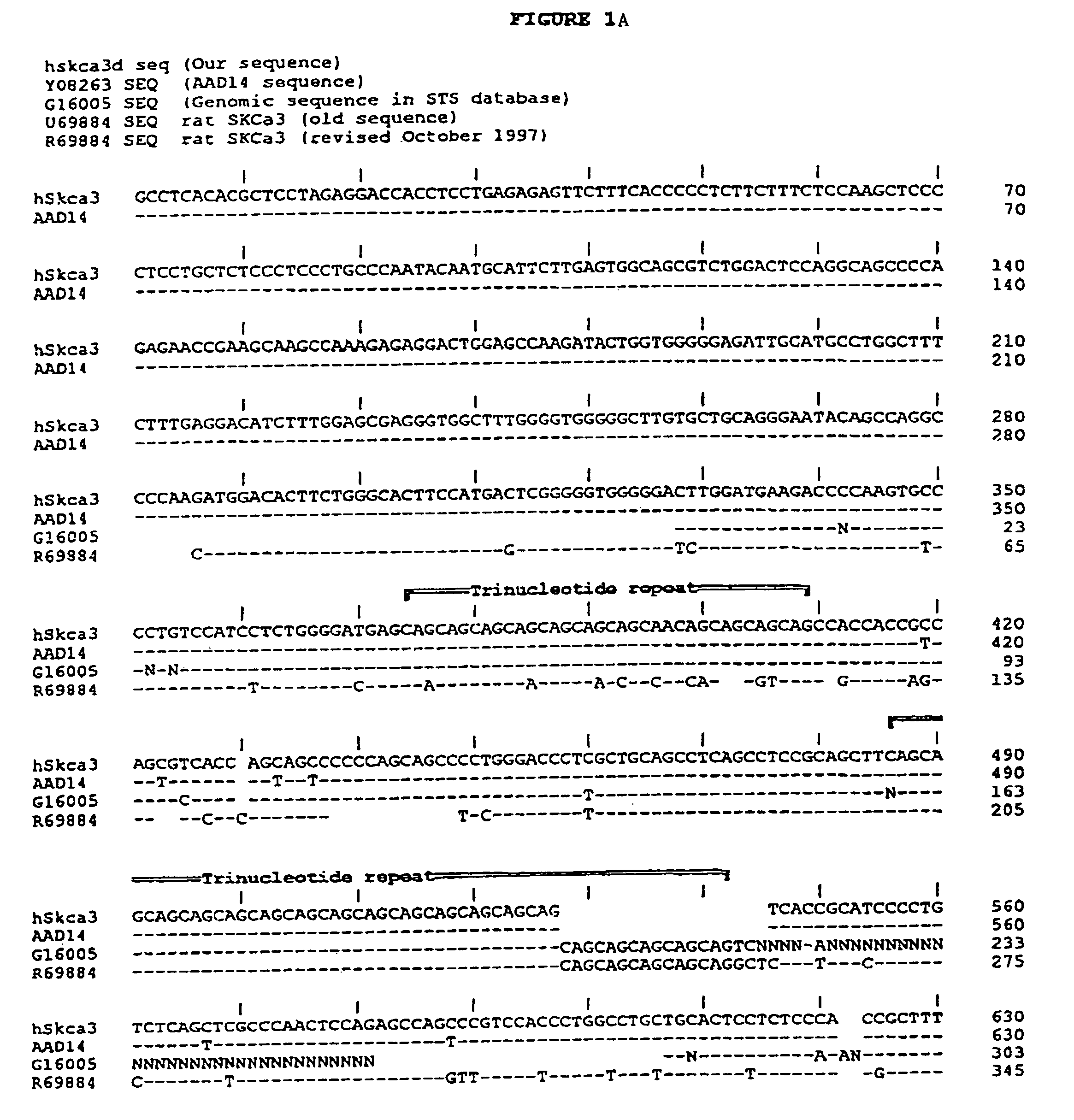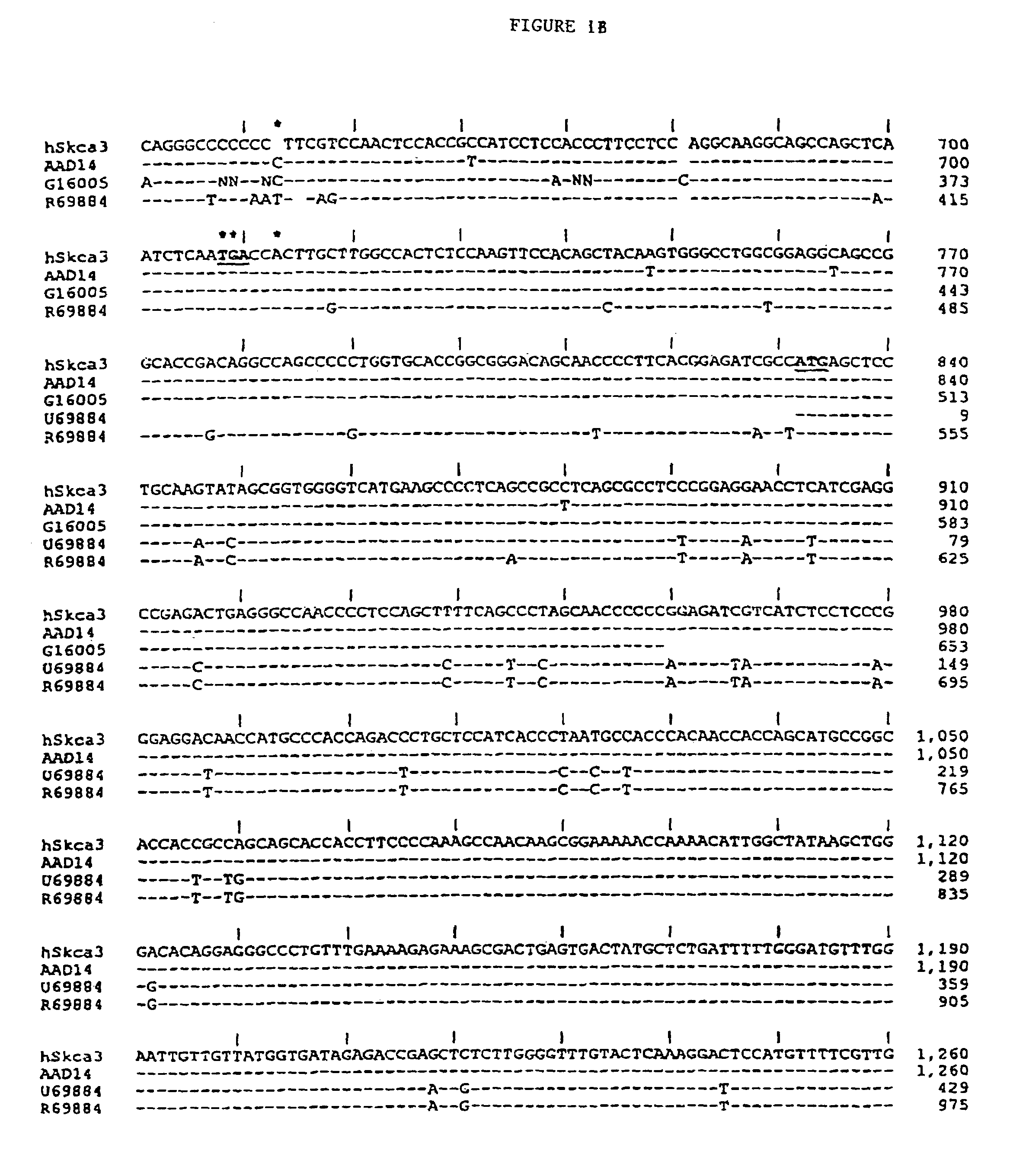hKCa3/KCNN3 small conductance calcium activated potassium channel: a diagnostic marker and therapeutic target
a small conductance calcium activated potassium channel and kcnn3 technology, applied in the direction of peptides/protein ingredients, genetic material ingredients, peptides/proteins, etc., to achieve the effects of reducing neuronal injury, preventing stroke, and enhancing susceptibility to schizophrenia and/or bipolar disorder
- Summary
- Abstract
- Description
- Claims
- Application Information
AI Technical Summary
Benefits of technology
Problems solved by technology
Method used
Image
Examples
example 1
Gene Isolation Methods
[0133]A homology search was carried out for the human homolog of the newly discovered rat cDNA encoding a portion of the rSKCA3 channel (rat small conductance calcium-activated potassium channel, type 3) (accession # U69884). In a BLAST cDNA database search, the N-terminal regions of the rat cDNA encoding features of the channel not shared with other classes of potassium channels was used as a probe sequence. Such probes detected the 3′ untranslated region of an anonymous cDNA sequence, AAD14 (accession # Y08263). Approximately 95% of the putative coding sequence of the human homolog was found. This sequence had 89% identity with the rat SKCa3 sequence (FIGS. 1 and 3). Identity is only 45% and 40%, respectively, with the SKCa1 (accession # U69883) and SKCA2 (accession # U69882) channels, suggesting that this is truly the homolog of the type 3 channel.
[0134]The human genomic database was surveyed for anonymous sequence tagged sites (STSs) for homology with the A...
example 2
Expression in vitro
[0139]In a further construct, the 3′ end of the hKCa3 / KCNN3 gene was spliced into the AAD 14 cDNA at a unique Sphl site. A methionine was placed at the 5′-end of the coding region and the clone was placed under control of the SP6 promoter. A cRNA from this construct or from the DNA sequence corresponding to this construct was expressed in mammalian cells in order to characterize the biophysical and pharmacological properties of the channel. This construct, when expressed in manmnalian cell lines or amphibian oocytes, serves as an extremely valuable tool for high-throughput screening studies to identify hKCa3 / KCNN3-specific modulating agents; or agents that specifically alter other channels whose activity is a function of hKCa3 / KCNN3 activity, such compounds might have therapeutic value for the treatment of schizophrenia, bipolar disorder, or other neuropsychiatric disorders. Since hKCa3 / KCNN3 was initially isolated from lymphocytes, it might encode the small condu...
example 3
Diagnostic Test Methods
[0140]Pairs of PCR primers (listed below in table) were designed to that would allow amplification from genomic DNA the region of the hKCa3 / KCNN3 gene flanking the CAG repeats. These primer pairs were used sequentially. First the two unlabeled primers, 22QA and 22QB were used, and the resultant products were cloned into the TA cloning vector (PCRII, Invitrogen) and manually sequenced using as sequencing primers oligonucleotides based on vector sequence. This sequencing confirmed that both CAG repeats were polymorphic in the population.
[0141]For example, these PCR products, or nested PCR products produced by primers directed to the internal sequence, could be formed using either fluorescent-labeled primers or fluorescent nucleotides to form products of this reaction that could be run on an acrylamide gel in an automated sequence analysis system with fluorescence detection (Pharmacia) to resolve the size of the PCR product. This would reflect the number of the C...
PUM
| Property | Measurement | Unit |
|---|---|---|
| Temperature | aaaaa | aaaaa |
| Temperature | aaaaa | aaaaa |
| Temperature | aaaaa | aaaaa |
Abstract
Description
Claims
Application Information
 Login to View More
Login to View More - R&D
- Intellectual Property
- Life Sciences
- Materials
- Tech Scout
- Unparalleled Data Quality
- Higher Quality Content
- 60% Fewer Hallucinations
Browse by: Latest US Patents, China's latest patents, Technical Efficacy Thesaurus, Application Domain, Technology Topic, Popular Technical Reports.
© 2025 PatSnap. All rights reserved.Legal|Privacy policy|Modern Slavery Act Transparency Statement|Sitemap|About US| Contact US: help@patsnap.com



